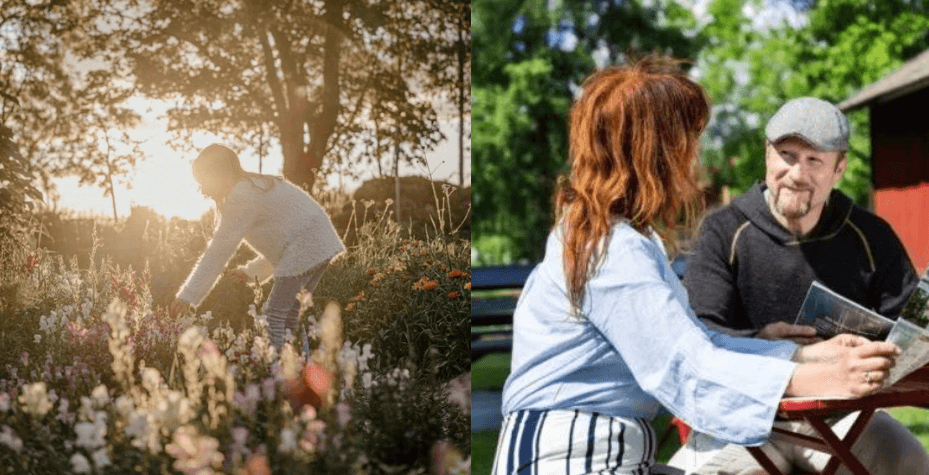Perhaps, however, its greatest treasure is its people – the locals. It’s the locals who understand the hidden beauty of the place, and who wish to share it with the wider world.
Coming into its sixth year, an initiative called ‘Meet the Locals’ has been connecting visitors with those who live and work in the region, opening them up to new experiences and a glimpse of different lifestyles. Visitors – or anyone curious about the region, or simply interested in having a unique cultural experience – get to come for the day and Meet a Local. Activities range from baking delicious Swedish cinnamon buns to going biking or hiking, going crab fishing, picking apples and making apple juice, or taking a ride in an Oldsmobile.
Together with the West Sweden Tourism Board, we meet two locals, Elizabeth and Sarah, and discover how this program is changing travel – and sometimes the lives of both visitor and local.

Spend a sunny summer day on the farm with Elizabeth
Everybody who meets Elizabeth Svensson describes her as a fantastic storyteller.
From spooky events at a local pond to personal tales of her family’s long history on the land, Elizabeth loves sharing what makes her region so special, often while knitting or cooking.
“We’re so blind to what we have at home, but you really notice how interesting people think it is. It’s fun to be able to show people that.”
Melissa Callahan, an American living in Sweden who visited with Elizabeth agrees: “She’s amazing. She is a great storyteller. Her family has been in the area so long and she has such a fantastic family history.”
It’s not just stories that Elizabeth has become known for. The retired healthcare specialist, who lives on the same farm that her grandfather built near Floby village, has drawn visitors back a number of times with her delicious creations, including the regional ‘hålkaka’.
What’s ‘hålkaka’? Elizabeth is only too happy to explain: “It’s a savoury bread. It’s round with a hole in the middle, thick and soft. It’s very normal here, and I make it from my grandmother’s recipe which I’ve inherited. I bake it at a high temperature with a stone hearth, like a pizza oven.
“I bake everything myself, it’s all homemade. I don’t buy anything ready-made from the shops. They also often have a story as well, my cakes – they can be my grandmother’s recipes from long ago, for example.”

For Elizabeth, the making and sharing of food with her visitors have led to deep connections and friendships within the ‘Meet the Locals’ program.
Speaking of a group of Japanese visitors she has hosted, she tells us: “I think we’ve definitely become friends for life. They’ve been here twice, and the third visit is planned shortly, before their student exchange is over.
“We’re very happy that these young girls from Japan came to visit us. It makes us proud that people want to come back and visit us. We’re really proud and think it’s so fun – we made sushi!”
Summer is the ideal time to come and visit the countryside – a colourful and serene place, far away from the crowds by the sea.
A day of stories, food, and a wander through the countryside with Elizabeth and her husband Leif is an opportunity to unwind, take time to enjoy the simple things, and learn more about Swedish rural life. It’s also easily accessible by public transport.
“If they don’t have a car then I’ll pick them up from the square in Floby, it’s only 10km to us, it’s no problem – there’s a train station there.”
Reflecting on her experience of her time with Elizabeth, Melissa reinforces the deep connection she felt meeting Elizabeth as a local: “The thing that I appreciated the most was that it was so welcoming. The whole experience was very comforting. I would totally do it again. Actually, I was just thinking about calling her up!”
Elizabeth’s tips for family-friendly activities in the area:
- Explore the ancient Nordic past at Ekehagens Forntidsby
- Enjoy a cosy night at the Nästegården Bed & Breakfast
- Stay in bucolic comfort at the Wrågården and Moose Hotel.
Explore the autumnal beauty of Hönö with Sarah
Sarah Lycksten, a photographer based in the Gothenburg archipelago, is very proud of her island home of Hönö.
“It has everything you need, like shops and cafes, but it’s also full of nature – we have two nature reserves on the island. I live five minutes away from the beach, and in many ways, it’s just like the old days.
“You also get different kinds of nature. One side of the island is very rugged, great for mountain climbing and bouldering, and the other side of the island is flatter, with forests, great for hiking.
“Even when the weather is bad, people love it.”
Consequently, Sarah cares deeply about preserving the beautiful state of the island and its ecosystems – sustainability is an issue close to her heart. This is, in part, why she decided to become involved in the program as one of the very first ‘locals’.
“When I first heard about ‘Meet the Locals’, I was studying ecotourism – that is, how to have people come to visit the island, in a sustainable way.”
“The best part is that now I get to show the beautiful natural space in which I live, but I also get to have conversations and learn about other cultures. Sometimes we really click. Everyone I’ve met has offered to show me around their own region!”
Sarah now shows visitors around the island in the form of hikes that can be catered to any ability and level of fitness. Sometimes, she even invites her visitors for a bracing swim.
“If you come, bring your swimming gear, I swim all year round. However, not everybody joins me!”

Even though she didn’t join Sarah in the water, Tripti Lalvani, originally from India now living in Gothenburg, had high praise for her time on Hönö.
“I spent almost a day with her. We walked around all of Hönö and I got to see the community and the beautiful nature. I also saw Sarah’s workshop, where she works with photographs. Yes, it was wonderful – an outstanding experience!
“I must have travelled to fifteen or twenty countries, and I haven’t encountered anything like this. These are people who want to show the very best of their country, and it gives people access to places many never think of visiting.
“Hönö is such a beautiful island, it’s a place I’ve returned to two or three times since meeting Sarah.
“The landscape of the islands is utterly unique – and even better: Hönö is very easily accessible. It’s easy to get to by bus and ferry.”
Sarah’s island hikes have made her one of the most popular ‘locals’ taking part in the program, with many visitors. What she wants to stress however is that Hönö and her hikes are something that can be done at any time of the year.
“I’d like to invite people to the island all year round – not just summer, but autumn and winter too, the island is especially beautiful all the time!”
Visiting the islands and the coast in September means less crowds, less traffic, but no less beautiful an environment – you can enjoy some of Sweden’s best scenery all to yourselves!
Sarah’s local tips on and around Hönö
- Experience beautiful landscapes along the Kustigen Coastal Path
- Go island-hopping by bike around the Gothenburg archipelago
- Learn about Hönö’s past at the Fishing Museum
Curious to explore?
Whether you’re living in Sweden or just visiting, Meet the Locals has something for everyone.
You might end up cruising around Låstad in a classic car or learning about the history of Gothenburg from a true local. You could be mountain biking through green forests, or baking iconic Swedish cinnamon buns – the possibilities grow each year.
‘Meet the Local’ offerings are free or low cost, are readily accessible by public transport and many are available no matter what the season. This is a program that everyone can take part in.
Join people from around the world in discovering western Sweden’s greatest treasures, its locals



 Please whitelist us to continue reading.
Please whitelist us to continue reading.
Member comments